The AMD Ryzen 3 3300X and 3100 CPU Review: A Budget Gaming Bonanza
by Dr. Ian Cutress on May 7, 2020 9:00 AM ESTCPU Performance: System Tests
Our System Test section focuses significantly on real-world testing, user experience, with a slight nod to throughput. In this section we cover application loading time, image processing, simple scientific physics, emulation, neural simulation, optimized compute, and 3D model development, with a combination of readily available and custom software. For some of these tests, the bigger suites such as PCMark do cover them (we publish those values in our office section), although multiple perspectives is always beneficial. In all our tests we will explain in-depth what is being tested, and how we are testing.
All of our benchmark results can also be found in our benchmark engine, Bench.
Application Load: GIMP 2.10.4
One of the most important aspects about user experience and workflow is how fast does a system respond. A good test of this is to see how long it takes for an application to load. Most applications these days, when on an SSD, load fairly instantly, however some office tools require asset pre-loading before being available. Most operating systems employ caching as well, so when certain software is loaded repeatedly (web browser, office tools), then can be initialized much quicker.
In our last suite, we tested how long it took to load a large PDF in Adobe Acrobat. Unfortunately this test was a nightmare to program for, and didn’t transfer over to Win10 RS3 easily. In the meantime we discovered an application that can automate this test, and we put it up against GIMP, a popular free open-source online photo editing tool, and the major alternative to Adobe Photoshop. We set it to load a large 50MB design template, and perform the load 10 times with 10 seconds in-between each. Due to caching, the first 3-5 results are often slower than the rest, and time to cache can be inconsistent, we take the average of the last five results to show CPU processing on cached loading.
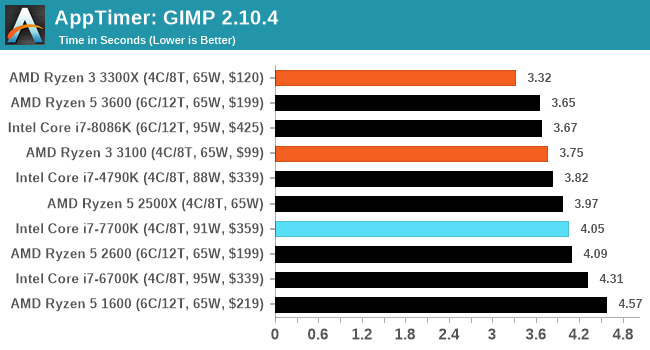
3D Particle Movement v2.1: Brownian Motion
Our 3DPM test is a custom built benchmark designed to simulate six different particle movement algorithms of points in a 3D space. The algorithms were developed as part of my PhD., and while ultimately perform best on a GPU, provide a good idea on how instruction streams are interpreted by different microarchitectures.
A key part of the algorithms is the random number generation – we use relatively fast generation which ends up implementing dependency chains in the code. The upgrade over the naïve first version of this code solved for false sharing in the caches, a major bottleneck. We are also looking at AVX2 and AVX512 versions of this benchmark for future reviews.
For this test, we run a stock particle set over the six algorithms for 20 seconds apiece, with 10 second pauses, and report the total rate of particle movement, in millions of operations (movements) per second. We have a non-AVX version and an AVX version, with the latter implementing AVX512 and AVX2 where possible.
3DPM v2.1 can be downloaded from our server: 3DPMv2.1.rar (13.0 MB)
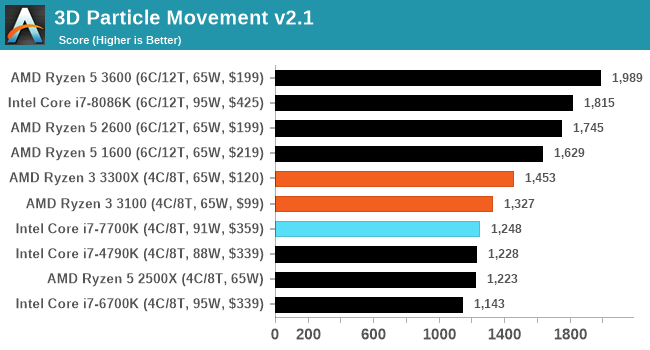
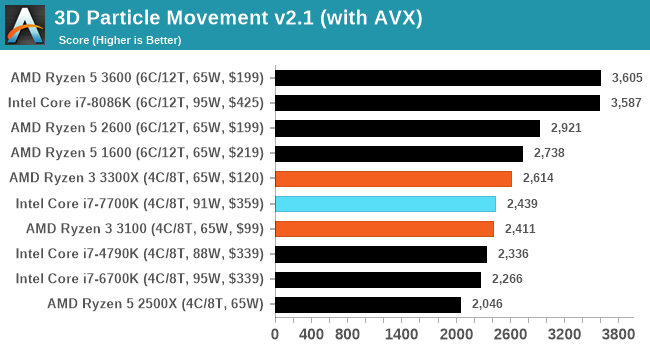
Dolphin 5.0: Console Emulation
One of the popular requested tests in our suite is to do with console emulation. Being able to pick up a game from an older system and run it as expected depends on the overhead of the emulator: it takes a significantly more powerful x86 system to be able to accurately emulate an older non-x86 console, especially if code for that console was made to abuse certain physical bugs in the hardware.
For our test, we use the popular Dolphin emulation software, and run a compute project through it to determine how close to a standard console system our processors can emulate. In this test, a Nintendo Wii would take around 1050 seconds.
The latest version of Dolphin can be downloaded from https://dolphin-emu.org/
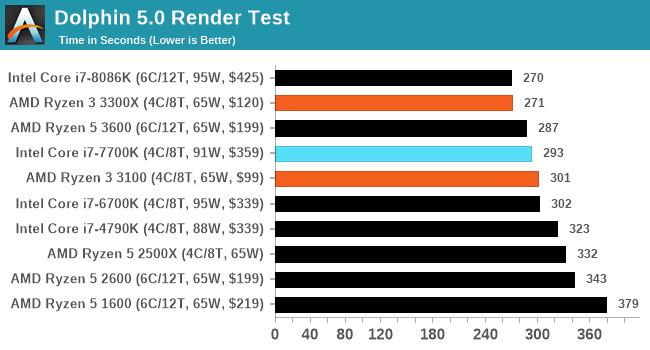
DigiCortex 1.20: Sea Slug Brain Simulation
This benchmark was originally designed for simulation and visualization of neuron and synapse activity, as is commonly found in the brain. The software comes with a variety of benchmark modes, and we take the small benchmark which runs a 32k neuron / 1.8B synapse simulation, equivalent to a Sea Slug.
Example of a 2.1B neuron simulation
We report the results as the ability to simulate the data as a fraction of real-time, so anything above a ‘one’ is suitable for real-time work. Out of the two modes, a ‘non-firing’ mode which is DRAM heavy and a ‘firing’ mode which has CPU work, we choose the latter. Despite this, the benchmark is still affected by DRAM speed a fair amount.
DigiCortex can be downloaded from http://www.digicortex.net/
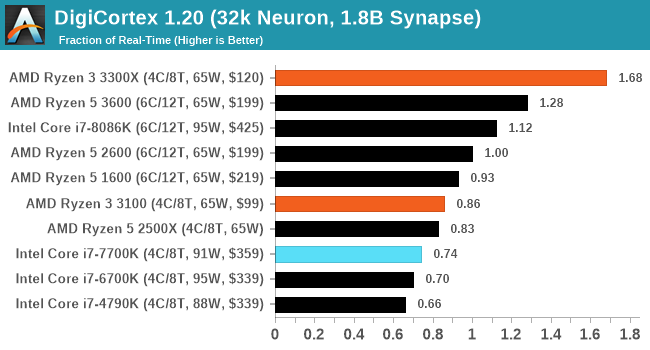
y-Cruncher v0.7.6: Microarchitecture Optimized Compute
I’ve known about y-Cruncher for a while, as a tool to help compute various mathematical constants, but it wasn’t until I began talking with its developer, Alex Yee, a researcher from NWU and now software optimization developer, that I realized that he has optimized the software like crazy to get the best performance. Naturally, any simulation that can take 20+ days can benefit from a 1% performance increase! Alex started y-cruncher as a high-school project, but it is now at a state where Alex is keeping it up to date to take advantage of the latest instruction sets before they are even made available in hardware.
For our test we run y-cruncher v0.7.6 through all the different optimized variants of the binary, single threaded and multi-threaded, including the AVX-512 optimized binaries. The test is to calculate 250m digits of Pi, and we use the single threaded and multi-threaded versions of this test.
Users can download y-cruncher from Alex’s website: http://www.numberworld.org/y-cruncher/
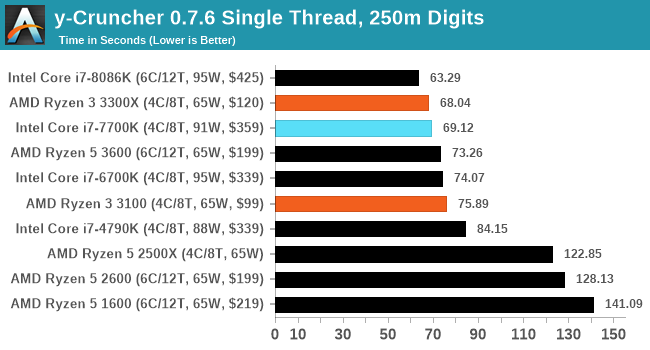
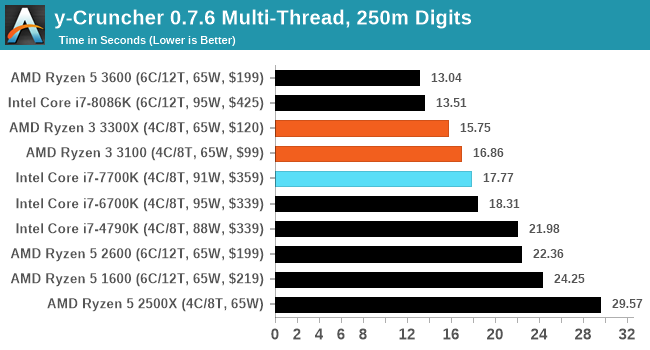
Agisoft Photoscan 1.3.3: 2D Image to 3D Model Conversion
One of the ISVs that we have worked with for a number of years is Agisoft, who develop software called PhotoScan that transforms a number of 2D images into a 3D model. This is an important tool in model development and archiving, and relies on a number of single threaded and multi-threaded algorithms to go from one side of the computation to the other.
In our test, we take v1.3.3 of the software with a good sized data set of 84 x 18 megapixel photos and push it through a reasonably fast variant of the algorithms, but is still more stringent than our 2017 test. We report the total time to complete the process.
Agisoft’s Photoscan website can be found here: http://www.agisoft.com/













249 Comments
View All Comments
PeterCollier - Monday, May 11, 2020 - link
Did you really feel the need to add 40 comments a week later the article was published? And on a Monday? Please tell us what company, Intel or AMD, that you work for.Spunjji - Tuesday, May 12, 2020 - link
Yes, reading article comments five days "late" definitely indicates that I work for a tech company, and not that I only visit this place once or twice a week during my lunch break. But hey, basing trolls is what I do for amusement. What's your excuse for trolling in the first place?kepstin - Friday, May 8, 2020 - link
I suspect that the 2600 was put into the charts as a stand-in for the 1600AF. The 1600AF should perform very close to the 2600 in most benchmarks - just a touch slower due to reduced clock speeds.rabidpeach - Friday, May 8, 2020 - link
1600af is represented by the 2600. the 2600 is just slightly better than it. this is not a problem. also amazon is out of them. the only benchmarks these processors win are high core count. daily life the 100 3100 will be faster so why hobble yourself with the smaller cache and 12nm?DanNeely - Thursday, May 7, 2020 - link
Something I've been wondering about for a while, is that when the first Ryzen announcements were made I read articles saying that the inclusion of some SATA/USB on the CPU itself would allow for cheaper entry level mobos/systems that used the CPU as an SoC without a chipset at all. However I don't recall ever seeing anything built that way. I'm inclined to doubt that it is possible but that no one has ever done it because for a low end system without a discrete GPU the CPU appears to have enough IO to cover all the bases. Were the initial reports wrong? Is it something that's only shown up in cheap OEM systems but never DIY boards?neblogai - Thursday, May 7, 2020 - link
Deskmini A300 is made this way- althouth it has no dGPU slot and requires an APU. This also allows the PC to idle at just 8-10W, compared to ~20W(?) for PCs that use motherboards with chipsets.DanNeely - Friday, May 8, 2020 - link
just one system by a single vendor. Kinda disappointing IMO since the CPU has enough connectivity for a basic no frills system, and would've been a reasonable option for a budget mITX board.Spunjji - Monday, May 11, 2020 - link
Agreed. I'd love to build a system in my existing USFF ITX case using something like an ITX version of the Deskmini A300 board, but for some reason nobody's doing it. I'm genuinely cluesless as to what "some reason" might be, too, as the A300 proves the concept just fine.Slash3 - Thursday, May 7, 2020 - link
ASRock's DeskMini A300 series systems are the closest configuration to this, lacking a secondary chipset.notb - Thursday, May 7, 2020 - link
A lot of focus in this text is about how 3300X ($120) compares to 7700K ($329, 3 years ago).Wouldn't it be nice to see how 3300X compares to high-end original Ryzen? ;)
The choice of CPUs is really weird. 8086K? 4790K? Really?
1600X, 1700, 1700X, 1800X - all probably beaten in most games and synthetic single-thread. In a lot of software as well (since 7700K used to beat 1800X occasionally).
1800X: $499